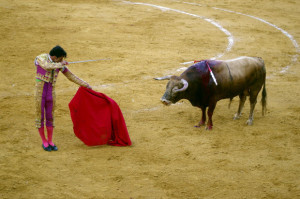 They call it a dance. A graceful compilation of movement equal to the brushstrokes of a painter. But neither the waltz nor impressionism end in the slaying of a living being, which is why so many people have a hard time accepting bullfighting as cultural. And while there are forms of non-lethal bullfighting being practiced today, opponents of the sport claim that the cruelty begins weeks and even months before the actual event takes place.
They call it a dance. A graceful compilation of movement equal to the brushstrokes of a painter. But neither the waltz nor impressionism end in the slaying of a living being, which is why so many people have a hard time accepting bullfighting as cultural. And while there are forms of non-lethal bullfighting being practiced today, opponents of the sport claim that the cruelty begins weeks and even months before the actual event takes place.
Still, there is more than a massive amount of supporters worldwide who laugh at those people who refer to bullfighting as a bloodsport. They cry foul, equating it to Americans not understanding cricket, for example.
So, is bullfighting culture, or cruelty?
What is bullfighting?
Bullfighting involves toreros of different levels, with the highest level of torero being called the famed matador. These toreros practice the art of bullfighting and pick up their own style of movements that are easily identified in the ring. People can identify a U2 song because of the Edge’s guitar sound; they can identify the make of a sports car because of the sound of the engine. Well, bullfighting enthusiasts can often identify a bullfighter, or at least the style of fighting he learned, by the movements he makes inside the ring.
These moves are made while the bull is within close proximity of the torero, and while there is a great level of risk involved whenever you’re in the same ring as a high-strug, massively sized beast like a bull, there are some “special” circumstances that are put into place that help give the bullfighter an upper hand, most of which take place during the first portion of the fight.
The thirds
Bullfighting rituals can change by region, but it’s often broken down into stages, or thirds, named Tercio de Varas (third of lances), Tercio de Banderillas (third of flags) and Tercio de Muerte (third of death). In the first stage the bullfighter sizes up the bull, his energy level and movements. Then two picadores come out with their lances and, get this now, blindfolded horses. This blindfolded horses are bait. The bull will see these horses and attack them. Using this as a distraction the picador will stab the bull in that mound of muscle on the bull’s neck. While this is happening, the bullfighter will take note of the preferred attacking style of the bull.
If all goes well in this first stage, the combination of blood loss and force exerted by the bull to left the horse up with its neck and horns will cause the bull to drop his head lower for the remainder of the fight. This makes the bull far more predictable and less dangerous. The bullfighter now has the upper hand.
Stage 2 is a bit of a misnomer. We’re not talking about real flags here that we wave in the sky on Fourth of July. We’re talking about sharp, barbed sticks planted into the bull’s shoulders. These are forced into the bull’s body by three banderilleros, although their attempts aren’t always successful. If they are successful, well, the bull is even further weakened, but also pretty angry.
Stage 3 shows us the matador, the chief bull fighter. He’s finally entered the ring after viewing all of the bull’s movements. He comes donning his muleta (red cape), as well as a sword. The bull fighter has 15 minutes to do what he came to do. Some call it dance. Some call is art. But if you get right down to it, the bullfighter has 15 minutes to kill the bull.
Before this final death blow, the matador performs different passes that are like a tango. It’s called the faena, and it’s the entire performance with red cape that we all know about bullfighting. The final series of passes leads to the bull being positioned for the kill, which comes at the hands of a thrust of the sword between the bull’s shoulder blades and through his heart. This final thrust is tricky, and the bullfighter must be careful with his approach so as not to fail the audience.
If the estocada (sword thrusting) is unsuccessful, the bull still gets killed. It’s just not as poetic as was intended. The matador is forced to prick the bull’s nose to lower his head and then severs the bull’s spinal cord. If, after that, the bull is still not dead, then a dagger is used (by another participant, not the matador) to completely pierce out the spinal cord.
Sometimes the bull’s body is dragged around the arena as an honor, if the presiding official was impressed with the animal. Sometimes (we mean rarely) the bull is granted a pardon for a “fine performance” (meaning the audience will wave its handkerchiefs before the estocada) and the matador will symbolically free the bull. If that happens – again, that’s rare – the bull will never fight again as it’s unwise to let a knowledgeable bull back into the ring.
If the matador did his job particularly well, then he might be awarded an ear of the bull. If he did extraordinarily well, my gosh he might get both ears, and even a tail!
History of Bullfighting
Bullfighting dates back to the 12th century, when soldiers who were fighting off boredom decided to fight animals. But most animals (deer, for example) were far too docile. After trying out various animals, the bull was decided as the most formidable opponent to such fierce soldiers as these knights. And thus bullfighting was born. The first bullfight took place in 1133 in honor of the coronation of King Alfonso VIII of Spain. That event led to the use of bullfighting as a way to mark important and historic events.
Culture or cruelty?
The sequence of events outlined above is the most typical description of bullfighting. Again, styles vary from region to region, and in some instances death is not a part of the sport, although that’s a significant minority. So that leaves you with this question to answer:
Is bullfighting a cultural staple of Spain and other countries, or is it just plain cruel?






No matter how many ways I look at bullfighting (tradition, culture, etc. etc. ) in my mind is plain and simple: It is cruelty to animals.
Bullfighting happens during ‘religious’ festivals, matter of face all ‘festivals’ involving the torture and killing of animals takes place in the name of religion. Just try to imagine Jesus sitting at a bullring cheering as his fathers animal children are treated and killed so brutally. My mind just cannot go there ! No – You will not find any art, any glory in any bullring ! What you will find is a slow sadistic torturing to death of an animal who has been well PREPARED before he is even sent into the ring. The origins of bullfighting, rather the cultural side is relatively new. My film, THE DANCE OF DEATH: Part 1
& Part 2
Learn more here: http://www.faace.co.uk/bullfight.html and http://www.league.org.uk/content/339/Bullfighting-Facts We filmed this in 1981 and sadly it has not changed much since then. However the majority of Spanish population do not support or have anything to do with the spectacle. And sadly for many years now the EU subsidizes it ! http://www.telegraph.co.uk/news/worldnews/europe/spain/10059944/Britain-funding-Spanish-bullfighting-via-EU-subsidies.html
Oh and remember too the countless horses that once sold to the bullrings will never leave alive, they have their vocal cords cut so their screams cannot be heard when gored. When injured, they are sent out, stitched up without the aid of medication, and if well enough, sent right back in for more. Their only purpose is to hold the picador high up so he can lance the bull over and over again in the bulls neck to damage the tossing muscle, another way of making the job of the next set of torturers and the killer, safer ….. living together in a field, these animals would live peacefully.
any animal that has spears put threw their body and to be chased is cruelty this animals has no choice in this ,if this animal had a choice do you really think they would do this?it is cruelty and it needs to stop
i was taken as a child and it is presented with different names for different moves which I guess are to make one feel it is brave and clever but it isn’t. I don’t understand why the spanish find this acceptable and I know that many many don’t anymore. It is torture inflicted by men who wish to appear macho but are in fact ridiculous and would be far better off finding positive ways of demonstrating their manhood. It i simply sadistic and horrific cruelty to a sentient creature and has nothing to do with anything else at all. Al Spaniards need to understand that it isn’t culture but brings their country into disrepute. All the more so when we see them teaching tiny children how to spear very young calves and take them to watch these horrors. It truly is very sick indeed.
Culture or cruelty??…….It should be Culture OF cruelty. Just because something has been around for hundreds or thousands of years does not make it right or ethical or acceptable. Animals feel mental and physical pain just like humans. Inflicting pain on an animal would be the same as inflicting pain on a human. Cruel. Unacceptable. Unnecessary.
This is not tradition. This is Animal Cruelty
cruelty
Bullfighters are just torturers/ murderers dressed as pink clowns! It´s not culture, has nothing to do with art, such a horrific event it´s a monstrosity! I just can´t understand why in this day and age some people still like it (minority) and want to justify this truly gruesome crime against innocent beautiful animals. The bullfights´fans are sick, alcoholic people that go to witness these horrors just to support the businessmen behind it. This is just about the $$$$. It is beyond me why these horrors still exist.
Great responses overall. Cruelty certainly is getting the nod here. Thanks for sharing your thoughts. I’m Colombian by heritage and was asked once to go to a fight while visiting family. While the investigative person in me wanted to see how it went, the pacifist in me could not commit my time to such a brutal display. I’d have never gotten those hours back, and would have hate to have spent it in a place like that.
Culture is not torture, and torture is not culture. My parents are from Spain and attend bullfights under the belief that it is part of the culture and the fact that the fighting bulls would die out as a race if it wasn’t for the bullfights. BS I say! However, I am pro-something and not anti-anything and while I wish to have bullfighting (and other types of animal torture) abolished, I would like to believe that it is part of our human/spiritual evolution. So will I abhor the act, I love the person who is doing his/her best to follow his/her spiritual path and I thank the bull for giving itself up to lead the journey. Who is to say that the bullfighter will not come back in the next lifetime as a vet?
Plain and simple: CRUELTY! Lots of Spanish people oppose to bullfighting as well. I think they should be even louder to end this shameful “entertainment” that cannot be called culture.
Comments are closed.